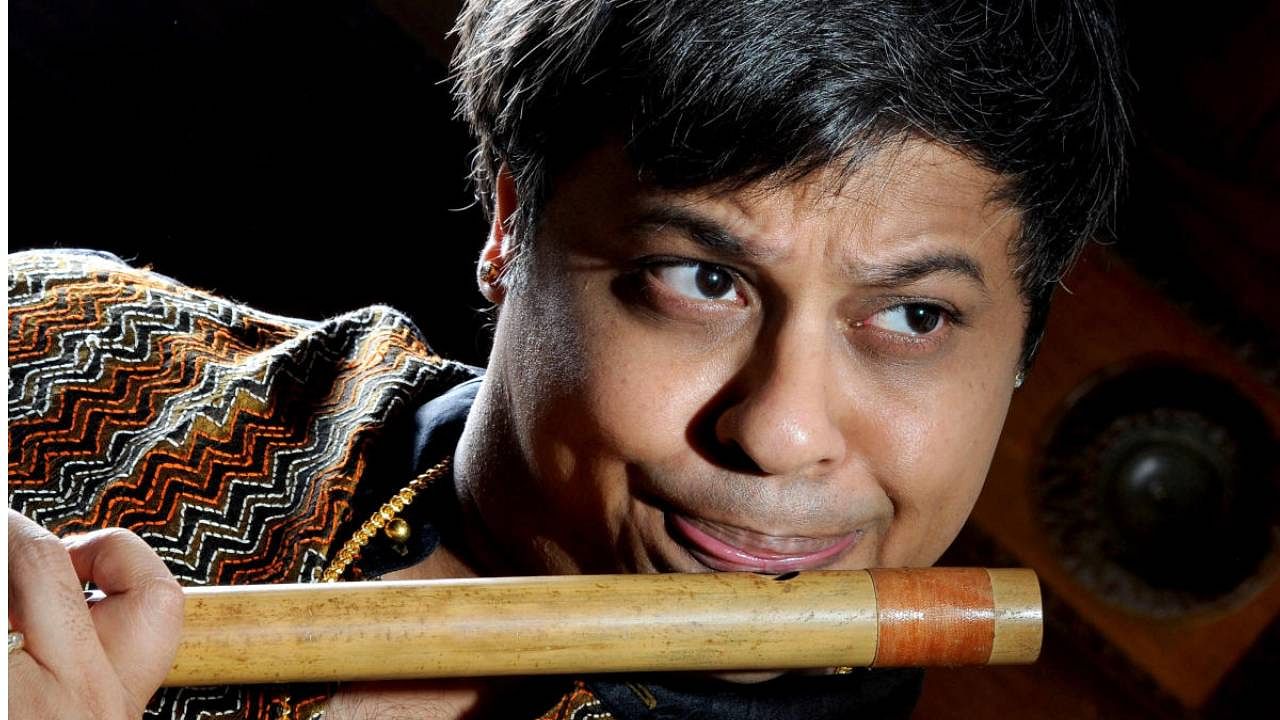
Flautist Shashank Subramanyam won the prestigious Chevalier Award from the French government this year. He is the first from Karnataka to receive this honour.
A child prodigy, Shashank could identify all 72 melakarta ragas when he was just three. His accomplishments, he told Showtime in an interview, rest on parental dedication and sacrifice.
Shashank's father M N Subramanyam, a professor at the University of Agricultural Sciences in Bengaluru, gave up his job to nurture Shashank’s creative genius. 'He is my first guru and bouncing board," says Shashank.
The flute maverick T R Mahalingam was among the first to notice Shashank’s unique style, and said he should be barred from any flute training lest he lost his touch. Shashank shouldn’t listen to any flautist, past or contemporary, or even his father, Mahalingam said. So vocal tutelage became the only permissible window for learning, and Subramanyam took Shashank to the renowned vocalist Palghat K V Narayanaswamy in Chennai. The family moved from Bengaluru to Chennai in 1986.
By the time he was 12, Shashank was already performing and travelling extensively. He trained under Hindustani vocalist Pandit Jasraj from 2005 till his passing in 2020. The two open-minded gurus allowed him to follow his musical instincts while they taught him the nuances of vocal music. Shashank, now 44, says his flute journey was full of challenges and discoveries.
Collaborations
Learning Hindustani music helped him bring in more melody into his Carnatic presentations, adding a new dimension to his art. Shashank enjoys jugalbandis as much as solo playing. To him, the jugalbandi is a beautiful way of presenting the music of pluralistic India. His collaborative music spans many genres. He has played with Chitraveena N Ravikiran, whom he describes as ‘a consummate musician’, Ustad Shahid Parvez, who has extended the frontiers of sitar-playing, and the legendary guitarist John McLaughlin. In the process, he has taken Carnatic music far and wide. Playing with Western musicians is a challenge since it involves working with complex harmonies. To integrate perfectly and professionally with other systems is crucial, he says.
Shashank loves the idea of adapting Carnatic ragas like Vachaspati, Shanmukhapriya and Simhendramadhyama into Hindustani music, and incorporating Hindustani percussive elements like tihayis into Carnatic music. Classical art forms must become more innovative in presentation, he observes, citing Indian film music as a model of innovation. “It connects to the knowledgeable and the common listener alike,” he says. In his view, the Hindustani system has adapted to change better than Carnatic music, and says sabhas can do a lot in ushering in innovation.
Bamboo experiments
He has collaborated with his flute makers to create instruments with better lower frequencies. “I was fortunate to find my tone early,” he says. That has remained his bani (style) and signature.
“In the history of Carnatic flute, Ramani was the first to play the base flute," he says. Shashank tried different materials, including PVC pipes, but the bamboo brings a unique resonance and a fine timbre.
Shashank’s itinerary is packed, and so he often teaches online. “Today’s students, especially non-Indians, may or may not stay with a teacher if strict conditions are imposed,” he says, speaking to this writer between flights. His audiences are diverse, ranging from corporate companies to European art music buffs to students to hard-core south Indian rasikas. This demands variation in format, he says.
North and south
Technically similar, but varying in their approach, the eight-hole Carnatic flute and the six-hole Hindustani flute stand together as kin instruments. Shashank feels the south Indian flute is best equipped to handle graces. “In the Hindustani system, a lot of space exists between fingers and it becomes difficult to reproduce the human voice exactly. In the Carnatic tradition, music had to be closer to the human voice. Instrumental musicians are not respected if their music is not faithful to the lyrics and akaaras. So it became imperative to invent new techniques to execute intricate gamakas and meends,” he says.
Karnataka roots
Shashank becomes the first recipient of the Chevalier honour from Karnataka. A fluent Kannada speaker, he describes Bengaluru as “a melting pot of all cultures”. His mother hails from Rudrapatna, a hub of Sanketi Brahmins, and his father from Hassan. Moving from Bangalore to Chennai in search of music, Shashank made a U-turn to Bangalore to find his life partner Shirisha, a Bharatanatyam dancer.
About the award
The Chevalier Award instituted by Napoleon Bonaparte in 1802 is the highest award given by the French government in the field of art, irrespective of nationality.
This year, Carnatic vocalist Vidushi Aruna Sairam and Shashank enter the Chevalier galaxy, studded by Indian classical musicians Manna Dey (1985) Pandit Ravishankar (2000), Dr M Balamuralikrishna (2005), and Lata Mangeshkar (2007).